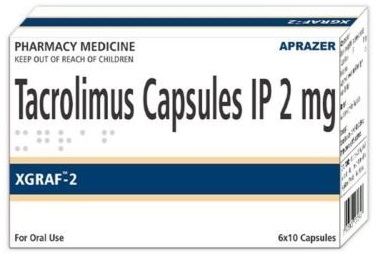Xgraf 2 Capsule
| Product Name | Xgraf 2 |
| Composition | Tacrolimus (2mg) |
| Dose/Strength | 2mg |
| Form | Capsules |
| Manufactured By | Aprazer Healthcare Pvt Ltd |
| packaging Size | 6?10 Capsules |
| Prescription | Required |
| Storage | Store below 30?C |
Xgraf 2
With other medications, Xgraf 2 is used to prevent your body from rejecting a new organ (such as a liver, kidney, or heart) after transplant. So it weakens your body’s immune system so that the new organ is not attacked. Immunosuppressants are the class of medications this medication belongs to.
How much Xgraf 2 you take and how often you take it depends on the type of transplant, your body weight, and the medicines you’re already taking.? Take your doctor’s advice very seriously. At least an hour before or two hours after a meal, you should take it on an empty stomach to get the most benefit. Even if you are feeling better, it is important to continue taking this medication consistently in order to get the full benefits. Transplant rejection is more likely if you stop taking the medication
It is possible to get adverse effects when taking Xgraf 2s. Diabetes, as well as renal and liver disorders, can be caused or worsened by it. Medical treatment is required immediately. Nausea, stomach pain, diarrhea, and trouble sleeping are some typical adverse effects. Consult?your doctor if the side effects don’t go away or get worse. Infections are more likely to spread when your immune system is weakened by Xgraf 2s.
Make sure your doctor is aware of any medical conditions that may affect your health before using this medication. These include kidney, liver, heart, or diabetic issues. Keep in mind that you should also tell your doctor about any other medications you’re currently taking for things like infections, pain, or arthritis. These and other factors could influence or be influenced by the drug. If you are on immunosuppressants, you should minimise your exposure to the sun and UV (ultraviolet) light.
Effective contraception should be used by both men and women who are taking this medication to avoid pregnancy. In most cases, this medication should not be used during pregnancy or breast-feeding unless absolutely necessary. Before and during treatment, you’ll need regular medical examinations to stay updated on your health and well-being, including blood pressure checks.
Indication
Prevention of organ rejection in transplant patients
Benefits
In Prevention of organ rejection in transplant patients
Xgraf 2 belongs to a class of drugs known as immunosuppressants and is used to prevent organ rejection in transplant recipients. When your immune system sees a new organ as an intruder and attacks it, it’s called organ rejection. This medication minimizes the likelihood of your body attacking the donated organ by weakening your immune response. It’s used in conjunction with other medications to increase your chances of a successful transplant. As long as your doctor has not really advised you to stop taking the medication, you should keep taking it.
Side effects
Most side effects don’t need to be treated by a doctor, and they go away as your body adapts to the medicine. You should consult your doctor if the symptoms continue or if you are concerned.
Common side effects of Xgraf 2

- Diarrhea
- Increased glucose level in blood
- Increased thirst
- Kidney damage
- Liver damage
- Nausea
- Stomach pain
How to use
Dosage and duration should be followed exactly as prescribed by your physician. Xgraf 2 should be taken without meal.
How it works
Xgraf 2?is an immunosuppressive drug. Your immune system is suppressed following an organ transplant with this medication (e.g., liver, kidney, heart). This allows your body to accept the new organ as if it were an integral part of you.
Precautions
Alcohol – UNSAFE
Consuming alcohol while taking Xgraf 2 is unsafe.
Pregnancy – SEEK THE ADVICE OF YOUR DOCTOR
Xgraf 2 is unsafe for Pregnant women. Despite the lack of human studies, animal studies have indicated negative consequences on the development of the unborn. Before prescribing it to you, your doctor will consider both the benefits and the hazards. Please seek medical advice.
Breast feeding – SEEK THE ADVICE OF YOUR DOCTOR
Use of Xgraf 2 while breast-feeding is most likely harmful to the infant. The medicine may enter into the breast milk and harm the baby, according to a minimal amount of human data.
Driving – UNSAFE
Xgraf 2 may impair alertness, impair eyesight, or make you sleepy and dizzy while driving. If these symptoms appear, do not drive.
Kidney – CAUTION
In patients with kidney disease, Xgraf 2 should be taken with caution. Xgraf 2 dosage may need to be adjusted. Please seek medical advice.
Liver – CAUTION
In patients with liver disease, Xgraf 2 should be taken with caution. The dosage of Xgraf 2 may have to be adjusted. Please seek medical advice.
Tips
- Organ transplant patients can take Xgraf 2 to prevent organ rejection.
- Take Xgraf 2 as soon as you remember if you miss a dose. If your next dose is nearing, skip the missed one and return to your regular schedule instead. It is not recommended to take two doses of the medication at the same time.
- The medication may take 3 to 4 months to work. Continue to take it as directed.
- Your blood cell count may be monitored by your doctor on a regular basis using blood tests. If you see unexplained bruising or bleeding, a sore throat, oral ulcers, a fever, or any other symptoms, consult your doctor.
- Your kidneys may be monitored by your doctor on a regular basis. For optimal kidney function, drink 8 to 10 glasses of water daily.
- Please consult your physician before discontinuing Xgraf 2.
Packing
10 capsules in 1 strip
| Brand | |
|---|---|
| Salt |

 Hepatitis C
Hepatitis C HIV
HIV Transplant Medicine
Transplant Medicine Respiratory System
Respiratory System









Reviews
There are no reviews yet.